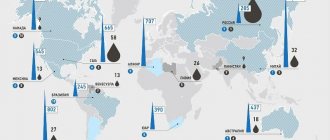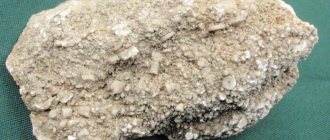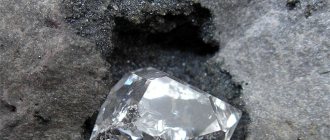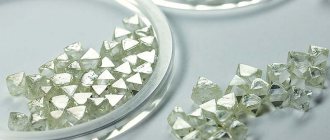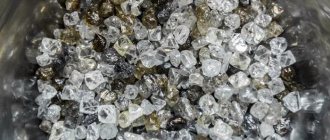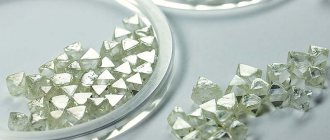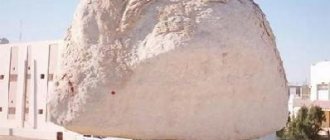Limestone is one of the most common sedimentary rocks of the carbonate type, usually consisting predominantly of calcite with terrigenous and organic impurities, dolomite. Its formation is associated with sea basins. Moreover, the properties of the rock, such as color, structure, texture, are determined by the type and conditions of formation.
- Careers
- Genesis
- Spreading
- Place of Birth
Order service
Fill out an application and we will contact you shortly
Careers
The quarry is an open-type development in the form of a set of excavations. Deepening is carried out as the resource is extracted layer by layer with a reduction in diameter due to ledges. If necessary, make an extension. Below we look at several limestone quarries.
Quarries near Moscow
This territory is poor in mineral resources. Limestone is one of the few resources. Its mining has been carried out here for a long time. The productive strata of this rock in the Moscow region are represented by deposits predominantly of the Carboniferous system. Basically they belong to 2-3 horizons. These are organogenic limestones, saturated with organic residues
Crimean quarries
The Crimean peninsula is rich in deposits of sedimentary rocks used as building materials. In addition to limestone, gypsum, marl, sand, anhydrite, etc. are common here. About 20 mining enterprises operate in this area, developing 60 quarries.
Vladimir limestone
The Vladimir region has significant reserves of carbonate raw materials. Moreover, it is used in various industries. Thus, here are the country's largest deposits for some of them: glass and agricultural. In addition, this is one of the areas confined to deposits of the best raw materials for the production of building materials.
Dagestan limestone
Dagestan has large reserves of carbonate raw materials. Such breeds are common over a significant part of the republic’s territory. There are many deposits and quarries here, many of which produce limestones with individual characteristics. However, most of the reserves have not been developed, and the developed raw materials are mainly used for the production of building materials for domestic needs and export to other regions.
Limestone deposits in the world
Limestone has been used in construction since the time of the first empires. Structures built from this material throughout human history have survived to this day, including historical cultural heritage sites.
How is limestone mined?
How is limestone mined
Limestone is mined in quarries. This option for extracting minerals is called open. At the first stage, so-called stripping operations are carried out. They involve removing the top layers of soil under which the mineral is located. During the operation of the quarry, mining is carried out directly. After its completion, reclamation measures are carried out.
The mining procedure involves grinding (crushing) the rock on site, followed by transporting it to the processing site. Explosions and other methods and technologies are used to grind it. The latter include excavators - giant machines that dig into a layer of limestone rock. Hydraulic loosening methods are also used.
Genesis
By genesis we mean the history of the origin of any geological formations.
There are 4 mechanisms of limestone formation
- Organogenic. Formation occurs by the accumulation of remains and entire skeletons of organisms in marine basins with a small proportion of predominantly carbonate cement.
- Chemogenic. Involves the precipitation of lime from seawater and subsequent recrystallization.
- Clastic. Formation due to denudation of carbonate and other rocks and skeletal remains, mainly in marine basins and on coasts.
- Mixed. It implies parallel or sequential superposition of various processes of rock formation of carbonate sediments.
Classification
A common type of rock is shell rock, which consists of shells of marine animals and their fragments. There are other types of limestone:
- Bryozoan, which includes the remains of bryozoans - small invertebrate animals that live in colonies in the seas.
- Nummulite, consisting of extinct single-celled nummulite organisms.
- Marbled. It can be thin-layered or massively layered.
During metamorphism, a process of recrystallization occurs with limestone, due to which this rock forms marble.
Limestone is considered a monomineral rock, the method of extraction of which may differ depending on the type of impurities, structure, and geological age. There are organizations that are engaged in extracting limestone. Places and methods of extraction are determined by terrain, types of rocks and other characteristics.
Types of deposits
Limestone, like other carbonate rocks, is found primarily in strata and reef deposits. Strata deposits are plate-shaped bodies, the location of which is determined stratigraphically or lithologically, that is, they are characteristic of deposits of specific varieties or ages. The occurrence is usually consistent with the host rocks. Such bodies are characterized by simple (with a gradual decrease in power) or blunt (with splitting) pinching out. Dimensions range from hundreds of meters to several kilometers in length, and up to tens of meters in thickness.
Reefs are elevations of the seabed in shallow water that are formed by the destruction of rocky material, the deposition of terrigenous material, or the accumulation of organic matter. Carbonate deposits are associated with the third type. Organic reefs are created by colonies of predominantly calcareous algae and coral polyps. The dimensions of such buildings are hundreds of meters in length. They are characterized by a homogeneous, often zonal structure.
Extraction methods
Mining is carried out using an open pit method. The top layer of soil and clay is removed. This is how a quarry is formed. Limestone mining involves performing pyrotechnic work to crush and separate portions of rock. Then it is transported by car for processing.
The world's first extraction method is considered to be the breaking method. This name was obtained due to the fact that the rock was removed with crowbars, and then the stones were knocked out of the formation with hammers. An alternative to this method is now being used. The blasting method is used. The rock produces fine crumbs. An excavator collects it, loads it onto dump trucks, and then everything is transported to the plant, where processing and cleaning are carried out.
There is a special device for an excavator with which limestone can be extracted without an explosion. The driver exchanges the bucket for an attachment that loosens the rock. This method is used in areas with high population density. There is a mining method using a milling combine. This is the most profitable option. At the same time, mining, crushing, and transportation of rock are carried out.
Spreading
Limestone is one of the most widespread rocks of the sedimentary cover, accounting for 19-22% of its mass. The deposits range from Precambrian to Quaternary sediments. Silurian, Carboniferous, Jurassic and Upper Cretaceous sediments are richest in it. The thickness of the strata ranges from several cm to 5 km.
The main accumulations of limestone are concentrated in the territories of ancient sea basins. Thus, in the territory that was part of the USSR, it is distributed in the North Caucasus, the Volga region, Siberia, the center of the European part, the Urals, Moldova, Azerbaijan, Crimea, and the Baltic states.
Features of the traditional method
The old method is used to extract limestone slabs. You just need to find a way out from underground. Then a shovel is used to clear the area where mining will take place.
Use a crowbar to create a crack in the limestone slab, and then pry the edge of the slab and lift it. Since the limestone is located underground in layers, only a small plate of it should be lifted. It must be pulled out from the place where the limestone lies. They cut the rock with a regular saw. To simplify the work, the tool is moistened in water.
Place of Birth
Vsevolodo-Vilvenskoye field
The search for limestone in this area was driven by the need for flux for metallurgical plants that had been operating here since the beginning of the 17th century. Development began in 1903. The deposit area is composed of carbonates of the Asselian and Sakmarian stages of the Permian and Carboniferous periods. The first quarry was founded in the town of Staraya. Since the end of the 19th century. the deposit provided raw materials
Berezniki Soda Plant
The deposit includes several quarries.
- Morozovsky. Located on the northern site. Dimensions are 1700x250 m, depth - 33 m.
- Alexandrovsky. Located in the south of the deposit. Dimensions – 900x300 m, depth – 70 m.
- Shavrinsky. Located near the village of Aleksandrovsk. Dimensions are 800x240 m, depth – 70 m.
The reserves of these quarries have long been exhausted. Filled with water, they formed lakes. The main reserves of pure limestone of the deposit as a whole have also been developed. Nowadays it is mined in several small quarries. The deposit was mainly reoriented to the development of construction crushed stone.
Galyanskoye field
Exploration in these places was carried out in sections: in 2 stages from 1946 to 1954 - in the Galyansky section, from 1969 to 1972 - in the western strip. The Gorbunovsky quarry was the first to be developed here in the 60s. The raw materials were used for blast furnace and sinter production. However, the development of the limestone deposit as a whole began in 1978 with the development of the first quarry. The work was complicated by local peaty soils. In addition, with progress, significant karst formation was revealed (20-32%), which significantly reduced the predicted reserves. The raw materials were partially used to produce cement. In the last decade of the 20th century. production and production volumes declined significantly. By the middle of it, the Galyansky quarry was re-equipped for the extraction of marble and marbleized limestones for the finishing industry. In 2005, the quarry moved to the second stage.
Severo-Bogdanovichskoye field
Explored in 1971-1975. Development is carried out using drilling and blasting technology. The dimensions of the quarry in 2014 were 900x800 m, depth - 30 m. Local raw materials are suitable for the production of road concrete, lime, slaking products, crushed stone, rubble stone, construction, and road work.
Zhdanovskoye field
This is a relatively new field. Geological surveys began in 2011. They were based on historical facts of the use of limestone from these places: the Sarmatians in the 4th-2nd centuries. BC e. they created sculptures from it, and in the middle of the 18th century. Orenburg was rebuilt using raw materials from local quarries. In 2012, based on test results, a limestone deposit of the Permian period was established. It was isolated as the Sarmat variety based on its high density and uniformity. Limestone has a predominantly calcite composition, mainly consisting of 0.003-0.008 mm grains with an 8-10% proportion of organogenic-terrigenous material. Ore and quartz veinlets are absent. This determines the best strength, wear and frost resistance indicators for Russian limestones.
Description
The basis of limestone is calcium carbonate, a substance that can dissolve in water. As a result, karst is formed. It can decompose into bases and carbon dioxide. This is carried out at great depths, because due to the influence of the Earth’s heat, limestone forms gas for mineral waters.
Limestone may include admixtures of clay minerals, dolomite, quartz, gypsum, and pyrite. Natural limestone is light gray in color, although it can be black or white. Impurities give a blue, pink, yellow tint. Limestone mining is in demand due to its widespread use. The breed is durable and known for its unique characteristics that make it unlike other materials.
Application options
In the metallurgical industry it is used as a flux. It is considered the main component during the creation of cement and lime. It is used as an auxiliary component for the production of soda, mineral fertilizers, paper, sugar, and glass.
The material is also used to produce rubber, paints, soap, plastics, and mineral wool. It is in demand in the construction field for the production of facing and wall blocks. It is used for the construction of foundations and roads. Limestone mining makes it possible to supply the entire country with building materials.
